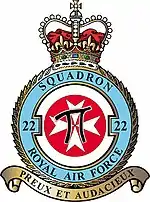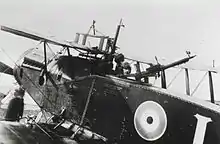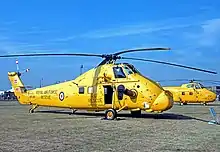No. 22 Squadron RAF
Number 22 Squadron of the Royal Air Force is an operational testing and evaluation squadron for all the Joint Helicopter Command helicopter types including Chinook, Puma HC2, Merlin HC4, Apache and Wildcat AH1. Formerly the Rotary Wing Operational Evaluation and Training Unit, the highly experienced helicopter aircrew will also ensure frontline crews have Qualified Warfare Instructors to support them on operations worldwide.[4] The squadron was reformed in May 2020 to serve as the Joint Helicopter Command Operational Evaluation Unit.[5]
| No. 22 Squadron RAF | |
|---|---|
 | |
| Active | 1 September 1915 – 1 April 1918 (RFC) 1 April 1918 – 31 December 1919 (RAF) 24 July 1923 – 1 May 1934 1 May 1934 – 30 September 1945 1 May 1946 – 15 August 1946 15 February 1955 – 5 October 2015 14 May 2020 – present |
| Role | Operational Evaluation Unit |
| Part of | Joint Helicopter Command |
| Garrison/HQ | RAF Benson |
| Motto(s) | Preux et audicieux (French: "Valiant and Brave")[1] |
| Equipment | |
| Battle honours |
|
| Commanders | |
| Officer Commanding | Wing Commander Andrew 'Keeno' Green |
| Insignia | |
| Squadron badge | On a Torteaux, a Maltese Cross throughout, overall a 'pi' fimbriated. |
| Squadron badge heraldry | Approved by King Edward VIII in May 1936. The Maltese cross denotes where the squadron was based when the badge was authorised. During this time it was based with No. 7 Squadron, having to fly over its lines away from the airfield symbolised by pi being 22 over 7.[3] |
| Squadron codes | VR (Apr 1939 – Sep 1939) OA (Sep 1939 – Nov 1944) |
The squadron previously operated the Westland Sea King HAR.3 and HAR.3A at three stations in the southern United Kingdom. It was originally formed in 1915 as an aerial reconnaissance unit of the Royal Flying Corps serving on the Western Front during the First World War. Becoming part of the Royal Air Force on its formation in 1918, it was disbanded the following year as part of the post-First World War scaling back of the RAF. During the Second World War the squadron operated in the torpedo bomber role over the North Sea and then in the Mediterranean and the Far East. Between 1955 and 2015 the squadron provided military search and rescue over the United Kingdom.
History
1915–19

The squadron was formed at Fort Grange, Gosport on 1 September 1915 from a nucleus of men and equipment split off from No. 13 Squadron.[6] The squadron trained on a variety of aircraft types, including the Royal Aircraft Factory BE.2c, the Maurice Farman Shorthorn, the Bleriot XI and the Curtiss JN-3. It received its intended operational type, the Royal Aircraft Factory FE.2b in February 1916, passing 14 BE.2s to 33 Squadron.[7]
The squadron moved to France on 1 April 1916, and soon settled down to carrying out reconnaissance missions over the front lines.[7] It flew fighter patrols during the Battle of the Somme in July 1916,[8] in addition to its normal reconnaissance and photography duties in support of the army.[9] One notable casualty during the Somme was Auberon Herbert, 9th Baron Lucas, the former Liberal politician and cabinet minister, who was wounded when attacked by German fighter aircraft on 3 November 1916, and died of his wounds the same day.[10]
From July 1917, the squadron started to replace its FE.2s with faster and more capable Bristol F.2 Fighters also known as the 'Brisfit', receiving its full complement of 18 aircraft by 24 August.[11] This was in time to allow the squadron to take part in the Battle of the Menin Road Ridge in September 1917.[12] The squadron was heavily deployed during the German spring offensive of 1918, and was forced to change bases due to the German advance,[11][13] and later, as the Allies drove the Germans out of France in the Hundred Days Offensive, changed bases to keep up with the Allied advances.[11]
The squadron moved to Spich, near Cologne in Germany as part of the British Army of Occupation in March 1919, leaving for home at the end of August that year. After a period as a cadre unit (without aircraft) at RAF Ford, the squadron formally disbanded on 31 December 1919.[14]
1923
The squadron's second incarnation was as one of two test squadrons (the other being 15 Squadron) supporting the Aeroplane Experimental Establishment at Martlesham Heath, Suffolk. For 10 years following its reformation on 24 July 1923, the squadron was involved in testing new aircraft before they were accepted for service or sold overseas. The two test squadrons were disbanded on 1 May 1934.[11]
1934–45
The squadron reformed again on 1 May 1934 at RAF Donibristle near Edinburgh, Scotland in the torpedo bomber role, flying Vickers Vildebeest I biplanes. From March 1935, the squadron began to re-equip with the improved Vildebeest III, with a more powerful engine and carrying an observer as a third crew member.[15] In October 1935, as part of Britain's response to the Abyssinia crisis, the squadron was deployed to Malta, returning to Britain in August 1936 after the threat of war between the United Kingdom and Italy receded.[16]
On 14 December 1936, part of the squadron was detached to form 42 Squadron, also equipped with the Vildebeest, while in March 1938, 22 Squadron moved south to RAF Thorney Island.[17]
The squadron was still equipped with the Vildebeest when the Second World War broke out in September 1939, with the squadron carrying out anti-submarine patrols over the English Channel.[18] From November 1939 the squadron started to receive Bristol Beaufort twin-engined monoplanes to replace its obsolete biplanes. The Bristol Taurus engines of the Beaufort proved unreliable at first, and the squadron continuing to fly operations with the Vildebeest while converting to the Beaufort. It flew its last operational mission with the Vildebeest on 20 December 1939.[19]
The squadron moved to RAF North Coates in Lincolnshire on 8 April 1940, flying its first operational sorties from that base on 15 April when nine Beauforts set out to lay mines off the mouth of the River Elbe.[19]
In this role, the unit flew sorties over the North Sea from North Coates, Thorney Island, St Eval and Portreath. In April 1941, a pilot of the unit, F/O Kenneth Campbell, was posthumously awarded the Victoria Cross for a daring attack on the Gneisenau in Brest harbour.[20]
In 1942, the unit was posted to North Africa before being moved to South East Asia, where it converted to the Bristol Beaufighter. No. 22 Squadron continued its anti-shipping role, this time using rockets. The squadron disbanded for the third time a month after war's end.[21]
Sycamore years
Reformed again in February 1955 with the Bristol Sycamore HC.12 at RAF Thorney Island, the squadron took on the Search and Rescue role with this helicopter until the Westland Whirlwind replaced it in June 1955.[22] The squadron performed military search and rescue until it was handed over to the Maritime & Coastguard Agency and Bristow Helicopters in October 2015.[23]
Whirlwind years
The squadron was initially equipped with Westland Whirlwind HAR.2s until August 1962, these were later replaced by the Whirlwind HAR.10s from August 1962. The squadron was based at RAF Thorney Island.[22]
June 1955 - June 1956 - HQ at RAF Thorney Island[22]
- Unknown Flight - RAF Valley, Anglesey
- Unknown Flight - RAF Felixstowe, Suffolk
- Unknown Flight - RAF Martlesham Heath, Suffolk
June 1956 - April 1974 - HQ at RAF St Mawgan, Cornwall[22]
- Unknown Flight - RAF Chivenor, Devon
- Unknown Flight - RAF Felixstowe, Suffolk
- Unknown Flight - RAF Tangmere, West Sussex
- Unknown Flight - RAF Thorney Island, West Sussex
- Unknown Flight - RAF Valley, Anglesey
- Unknown Flight - RAF Manston, Kent
- Unknown Flight - RAF Coltishall, Norfolk
April 1974 - January 1976 - HQ at RAF Thorney Island[22]
- Unknown Flight - RAF Valley, Anglesey
- Unknown Flight - RAF Chivenor, Devon
- B flight - RAF Coltishall, Norfolk
- Unknown Flight - RAF Brawdy, Pembrokeshire
January 1976 - June 1976 - HQ at RAF Finningley[22]
- Unknown Flight - RAF Valley, Anglesey
- Unknown Flight - RAF Chivenor, Devon
- Unknown Flight - RAF Brawdy, Pembrokeshire
- Unknown Flight - RAF Leuchars, Fife
- Unknown Flight - RAF Manston, Kent
- Unknown Flight - RAF Leconfield, East Riding of Yorkshire
Wessex years

The squadron was re-equipped with Westland Wessex's from June 1976.[22] Its headquarters were at RAF Finningley and it had flights at:
- 'A' Flight – RAF Chivenor, Devon
- 'B' Flight – RAF Leuchars, Fife (stood down 1 April 1993)[24]
- 'C' Flight – RAF Valley, Anglesey
- 'D' Flight – RAF Leconfield, East Riding of Yorkshire
- 'E' Flight – RAF Manston, Kent and RAF Coltishall, Norfolk (stood down 21 July 1994)[25]
Sea King years

Finally, in the mid-1990s, the squadron received six newly built Westland Sea King HAR.3A to supplement the Sea King HAR.3 aircraft which replaced the Wessex aircraft. The squadron HQ was co-located with the SAR Force HQ at RAF Valley on Anglesey, Wales.[26] Detachments of at least two aircraft operated from three stations providing search and rescue cover in those parts of the country; these were:[27]
- 'A' Flight – RMB Chivenor, Devon
- 'B' Flight – RAF Wattisham, Suffolk
- 'C' Flight – RAF Valley, Anglesey
- 'D' Flight - RAF Lossiemouth, Moray
A and B Flights operated the Sea King HAR.3A.[27] C Flight shared a pool nominally of five Sea King HAR.3 aircraft with 203 (R) Sqn, the Operational Conversion Unit.[26]
Prince William, Duke of Cambridge served in the squadron from 2010 to 2013.[28] At the end of 2015, the squadron was stood down and the Sea Kings disposed of when RAF Search and Rescue's responsibilities were handed over to a civilian contractor Bristow.[29]
In July 2015, C Flight stood down[30] with A Flight following on 5 October 2015.[31][32]
Notable rescues
- On 11 November 1962, the FV Jeanne Gougy ran aground and capsized at Land's End, Cornwall. Eight of her twenty crew were rescued by helicopter or breeches buoy. Sergeant Eric Smith was awarded a George Medal for his actions.[33]
- Boscastle flood of 2004 – The Boscastle flood of 2004 occurred on Monday, 16 August 2004 in the villages of Boscastle and Crackington Haven in Cornwall. The villages suffered extensive damage after flash floods caused by an exceptional amount of rain that fell over the course of eight hours that afternoon. Two Sea Kings from A-Flight at RMB Chivenor, Rescue's 169 and 170, were called and help to rescue some of the 100 people who were airlifted out.[34]
Test and evaluation (2020–present)
No. 22 Squadron reformed on 14 May 2020 at RAF Benson, Oxfordshire, as the Operational Evaluation Unit for the Joint Helicopter Command.[5]
Honours and awards
In addition to the battle honours listed above (which are emblazoned on the Squadron Standard), the squadron has been granted the following battle honours: Cambrai 1917, Somme 1918, Lys, Amiens, France and Low Countries 1940, Invasion Ports 1940, Biscay Ports 1940–1941.[35]
Flying Officer Kenneth Campbell was posthumously awarded the Victoria Cross for executing a torpedo attack on the German battleship Gneisenau in Brest harbour. Despite atrocious weather having prevented the other aircraft in the mission from reaching the harbour and, with virtually no chance of pulling out of the harbour, Campbell pressed home his attack and badly damaged the ship, being shot down in the process. He and his crew were buried with full military honours by the Germans in the cemetery at Brest.[21]
In popular culture
- BBC "Helicopter Rescue" broadcast in February 2012.[36]
See also
References
Citations
- Pine, L.G. (1983). A dictionary of mottoes (1 ed.). London: Routledge & Kegan Paul. p. 180. ISBN 0-7100-9339-X.
- "Royal Air Force". Royal Air Force.
- "22 Sqn". RAF Heraldry Trust. Retrieved 10 June 2020.
- "22 Squadron Royal Air Force". Royal Air Force. Retrieved 14 May 2020.
- "22 Squadron Re-Forms At RAF Benson". Royal Air Force. 14 May 2020. Retrieved 15 May 2020.
- Ashworth 1989, p. 76.
- Halley 1973, p. 11.
- Jones 1928, pp. 196, 230.
- Jones 1928, p. 252.
- Jones 1928, p. 314.
- Halley 1973, p. 13.
- Jones 1934, p. 181.
- Jones 1934, pp. 299, 312, 324, 327, 382.
- Halley 1973, pp. 13, 26.
- Halley 1973, pp. 13–14.
- Ashworth 1989, pp. 76–77.
- Halley 1973, pp. 14–15.
- Halley 1973, p. 15.
- Halley 1973, p. 16.
- Barker 1957, pp. 57–67.
- Ashworth 1989, p. 77.
- Jefford 1988, p. 32.
- Mander, Simon (15 October 2015). "Farewell to RAF UK Search and Rescue". www.raf.mod.uk. Royal Air Force. Archived from the original on 8 December 2015. Retrieved 9 July 2016.
- Jackson 1995, p. 12.
- Jackson 1995, p. 9.
- Heyman, Charles (2013). The armed forces of the European Union, 2014-2015. Barnsley: Pen & Sword Military. p. 138. ISBN 978-1-78346-351-0.
- Cotter 2008, p. 34.
- Jones, Tony (18 February 2016). "William and Kate farewell RAF search and rescue service on return to Anglesey". walesonline. Retrieved 25 May 2017.
- "Bristow Group to take over UK search and rescue from RAF". BBC News. 26 March 2013. Retrieved 27 August 2015.
- "RAF Sea King Lands For The Last Time". www.raf.mod.uk. Royal Air Force. 1 July 2015. Archived from the original on 2 January 2016. Retrieved 9 July 2016.
- "VIDEO: RAF Search and Rescue operations end as 22 Squadron is stood down". North Devon Journal. Archived from the original on 8 October 2015. Retrieved 30 December 2015.
- "Chivenor Sea King Completes Final RAF UK Operational Sortie". www.raf.mod.uk. Royal Air Force. 5 October 2015. Archived from the original on 4 March 2016. Retrieved 9 July 2016.
- "Sergeant Eric Smith GM". Aeroplane. No. May 2011. Cudham: Kelsey Publishing. p. 33. ISSN 0143-7240.
- Gussin, Tony (30 September 2015). "Chivenor's 22 Squadron: Saving lives in North Devon for 57 years". North Devon Gazette. Retrieved 25 May 2017.
- Ashworth 1989, p. 78.
- "Prince William in BBC search and rescue documentary". ITV News. 28 March 2013. Retrieved 25 May 2017.
Bibliography
- Ashworth, Chris (1989). Encyclopaedia of modern Royal Air Force squadrons. Wellingborough: Patrick Stephens. ISBN 1-85260-013-6.
- Barker, Ralph (1957). The Ship-Busters: The Story of the R.A.F. Torpedo-Bombers. London, UK: Chatto & Windus Ltd. ISBN 978-1-906502-29-4.
- Cotter, Jarrod (2008). Royal Air Force celebrating 90 years. Stamford, UK: Key Publishing Ltd. ISBN 978-0-946219-11-7.
- Halley, James J. Famous Maritime Squadrons of the RAF, Volume 1. Windsor, Berkshire, UK: Hylton Lacy Publishers Ltd., 1973. ISBN 0-85064-101-2.
- Halley, James J. The Squadrons of the Royal Air Force & Commonwealth, 1918–1988. Tonbridge, Kent, UK: Air-Britain (Historians) Ltd., 1988. ISBN 0-85130-164-9.
- Harvey, William Frederick James. 'Pi' in the Sky: History of No.22 Squadron, Royal Flying Corps and R.A.F.in the War of 1914–18. Colin Huston, 1971. ISBN 0-9501868-0-5.
- Jackson, P (1995). Royal Air Force (Second ed.). UK: Ian Allan Publishing. ISBN 0-7110-2338-7.
- Jefford, C G (1988). RAF Squadrons. A comprehensive record of the movement and equipment of all RAF squadrons and their antecedents since 1912. Shrewsbury: Airlife. ISBN 1-85310-053-6.
- Jones, H.A. "The War in the Air: Being the Story of the Part Played by the Royal Air Force in the Great War: Vol. II". History of the Great War. Oxford: The Clarendon Press, 1928.
- Jones, H.A. "The War in the Air: Being the Story of the Part Played by the Royal Air Force in the Great War: Vol. IV". History of the Great War. Oxford: The Clarendon Press, 1934.
- Moyes, Philip J.R. Bomber Squadrons of the RAF and their Aircraft. London: Macdonald and Jane's (Publishers) Ltd., 1964 (new edition 1976). ISBN 0-354-01027-1.
- Rawlings, John D.R. Coastal, Support and Special Squadrons of the RAF and their Aircraft. London: Jane's Publishing Company Ltd., 1982. ISBN 0-7106-0187-5.
- Rawlings, John D.R. Fighter Squadrons of the RAF and their Aircraft. London: Macdonald and Jane's (Publishers) Ltd., 1969 (new edition 1976, reprinted 1978). ISBN 0-354-01028-X.
External links
- "No. 22 Squadron". Royal Air Force. 2015. Archived from the original on 21 November 2016. Retrieved 29 December 2009.
- "No. 22 Squadron History 1915–1946". RAF Search and Rescue. 2015.
- "No. 22 Squadron bases 1939–1945". rafcommands.com. June 2000.
- "No. 22 Squadron Association". 2015.